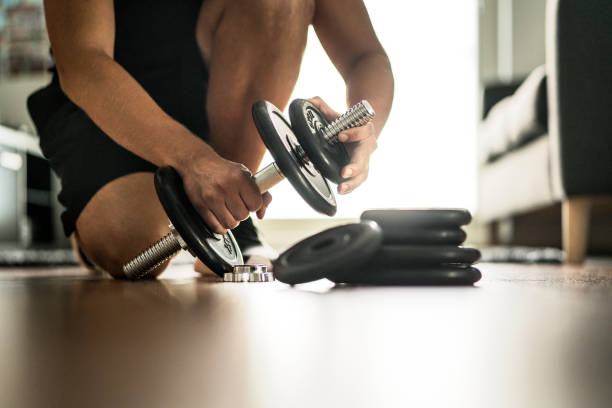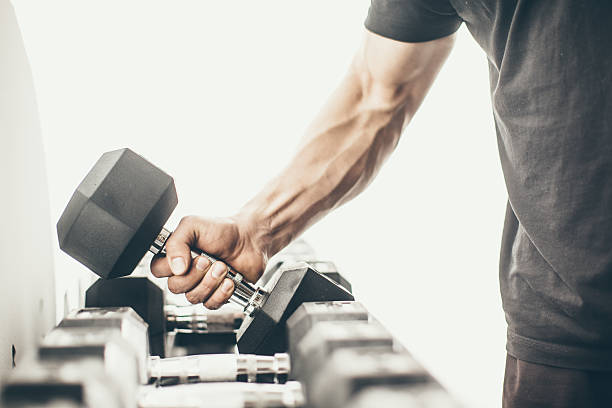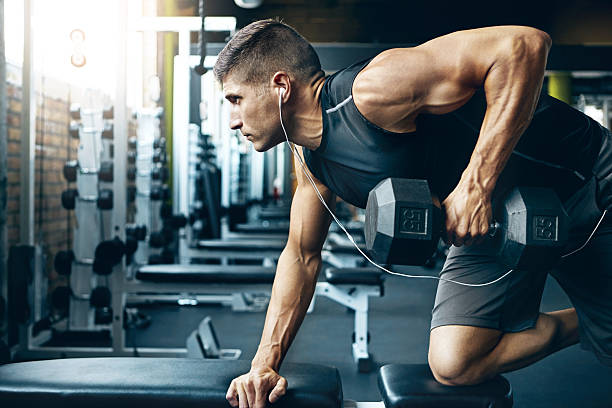The broad V-shaped muscles on the upper back are known as the lats, or latissimus dorsi, muscles. The lats are essential for developing functional strength as well as an athletic appearance.
Targeting the lats creates the appearance of a slimmer waist and a stronger torso.
This article is going to be for you if you don’t like pull-ups and barbell rows or if you’re short on equipment while working out at home.
With the right approach and exercises, it’s totally possible to target the lats with dumbbells. Fortunately, we’ve got your back—literally—and will soon walk you through an easy breakdown of these motions.
What Are Dumbbell Lat Exercises?
The sizes and shapes of dumbbells vary widely. You can choose between more modern rubberized versions and vintage rusted iron ones. Additionally, there are sets of adjustable dumbbell bars where you can add weight plates.
Dumbbell lat exercises are pulling, lifting, or rowing motions that work for the main back muscle groups regardless of the equipment you use.
Benefits of Dumbbell Lat Exercises
Using only a few pieces of gym equipment, you can complete a full back workout with dumbbell lat exercises. Additionally, you don’t have to wait for machines or racks to open up before switching exercises.
The compound movements used in many of these dumbbell lat exercises are better for increasing strength because they work for multiple muscle groups. In contrast to machines or cables, they also burn a lot of calories.
Dumbbells, last but not least, give you the option to choose the direction of the movement and work each arm separately. You can target particular lat and back muscle groups thanks to this freedom.
• Perform a complete lat workout at home with minimal equipment
• Free weights like dumbbells activate more muscle groups
• Burn more calories compared to machines or cables
• Able to work each lat independently or both lats simultaneously
• More body position options for targeting specific parts of the lats
15 Effective Dumbbell Lat Exercises
1. Standing Dumbbell Row
A common exercise for trying to develop the lats is the standing dumbbell row. Your feet should be about a shoulder’s width apart as you perform this movement.
Focus on bending at the waist and keeping your back straight while bending your knees. With your arms fully extended and your knuckles facing forward, hold out the dumbbells. Dumbbells are raised to your ribcage and then brought back to their starting position.
2. Wide Dumbbell Row
The wide dumbbell row is an excellent alternative to the standing dumbbell row for developing the lats. When performing this exercise, proper form is essential. As you would for a standard standing dumbbell row, position yourself. Pull the dumbbells into your chest while maintaining a slight gap between your arms and shoulders. Prior to repeating, make sure to revert to your starting position.
It’s also best to wait until you have mastered the standard standing row before attempting this.
3. One Arm Dumbbell Row
Lats can be targeted and isolated by performing one-arm dumbbell rows. A bench or a sturdy platform that is about thigh height is required for this exercise. Your arm should be on the same side as your leg as you kneel down on the bench and hold on to that arm.
Pick up the dumbbell with your palm facing your body while stooping so that your upper body is almost parallel to the ground. Dumbbell movement: slowly raise the dumbbell up next to your body to your chest.

4. Renegade Row
Rowing exercises are excellent for developing the lats, in case you hadn’t guessed by now. The renegade row is a challenging exercise that only needs some floor space and dumbbells to target a variety of muscles, including the abs.
With your toes on the ground and your hands on the dumbbells, assume a plank position while holding the dumbbells out in front of you.
From this position, raise one arm, bringing the dumbbell into your chest while supporting your body with the other. For this exercise, stick to a lighter weight!
5. Reverse Fly
Your feet should be spaced about hip-width apart as you stand. When lowering your chest until it is nearly parallel to the floor, keep your knees soft and your back straight. Your palms should be facing one another as your arms should hang in front of you.
Start from this position and raise your arms until they are parallel to your body. At the peak of this motion, make sure to squeeze your shoulder blades together. You can also do the reverse fly while seated on a bench.
6. Decline Dumbbell Pullover
A slightly less popular exercise that is extremely effective at toning your lats is the decline dumbbell pullover. Lie down on a bench with a 45-degree incline so that your head is lower than your legs.
If you don’t have a bench, you can do this exercise with your head just leaning off and your neck supported on any flat surface. Straight-armed, hold a single dumbbell above your head. Keep them straight as you lower the dumbbell behind your head in an arc motion and then raise it again.
7. Incline Row
The incline row is another row variation you should try out if you have access to a bench. Lean forward into your bench while angling it at a 45-degree angle.
Your chin should be resting on the bench as you hold the dumbbells by your sides with your knuckles pointing inward toward your body. From here, raise the dumbbells to your sides while pulling back on the shoulder blades.
As you perform this movement, make sure your torso is always straight and that you are not rotating your wrist.
8. Single Dumbbell Row
Most people use dumbbells to work their backs, and the single dumbbell row is one of the most common. The majority of the time, you will see this exercise being done while kneeling on a bench, as shown in the illustration below.
With both feet on the floor and your hands resting on a bench or other sturdy support, you can also perform the single dumbbell row. With your body in this position, you can increase your leg drive or alter your back’s angle to target your upper or lower lats more.
Start with your arm extended to stretch your shoulder blade, regardless of the stance and body alignment you use. Next, raise the dumbbell toward your ribcage while concentrating on pulling your shoulder blade back.
9. Dumbbell Pendlay Row
Glenn Pendlay, a US Olympic weightlifting coach, invented the bent-over row and later modified it to become the Pendlay row. Your upper body is almost parallel to the floor when performing the Pendlay row, which is one of its distinctive characteristics.
Every rep begins on the floor, which is another distinctive feature. Maximizing back muscle activation is the goal of this posture. Enhance your explosive power off the floor for other Olympic lifts as well.
Your knees should be slightly bent when you start. Additionally, you should have a relatively straight back and a straight-down downward gaze.
Pull the dumbbells up quickly, straight from the floor, and towards your sternum. Your elbows should extend to your sides while making a 45-degree angle with your body as you pull.

10. Renegade Row
A single dumbbell row performed in the push-up position is essentially what the renegade row is. Your core and additional stabilizer muscles must be used more actively when performing the row while lying on your back.
Dumbbells should be placed on the ground to start. Take hold of the dumbbell handles and maintain the push-up position. With one hand supporting your body up, lift one dumbbell off the floor and pull it toward your side.
You can perform a set number of reps on each side or switch sides after each rep. Doing a push-up in between each repetition is an additional option. This is comparable to a superset for a back and chest workout.
11. Kroc Row
The Kroc row is a very strenuous single-dumbbell row that is executed with your back at a 15–25 degree angle. In contrast to other rows, the Kroc row allows you to use momentum.
The Kroc row allows you to pull the heaviest dumbbells while keeping loose form and both feet on the ground. The goal is to strengthen the forearms and upper back in preparation for other strenuous pulling exercises like deadlifts.
Learn one hand against an inclined bench or another sturdy object to begin a Kroc row. Now take the dumbbell from your other hand and hold it out at arm’s length with your shoulder blade stretched forward.
From here, pull the dumbbell straight up and to your side by using the momentum your legs provide. Squeeze your shoulder blades together at the top and try to bring the dumbbell up to touch your rib cage as you concentrate on completing the entire range of motion.
12. Superman Pulls With Dumbbells
A horizontal pull-up is similar to the Superman pull. The Superman pull, then, differs from traditional pull-ups in that you do not have to lift your entire body weight.
Instead, you should pull your shoulder blades back as you pull yourself up while lying on your stomach. The lats and upper back stabilizers are worked by the external rotation of the arms.
While the Superman pull is difficult even without weights, you can add resistance by holding a pair of light dumbbells. The muscle imbalances caused by upper cross syndrome have also been corrected by my using this exercise.
13. Dumbbell Deadlift
A posterior chain exercise known as the deadlift targets the lats as well as nearly all other muscles on the backside of your body. And the dumbbell version is the same.
The weights should be at your sides to begin the dumbbell deadlift, but many people do this instead. This variant also referred to as a suitcase deadlift closely resembles a trap bar or hex bar deadlift.
Because it relies more on leg drive than back drive, that starting position is problematic. Therefore, hold the dumbbells in front of your legs like a barbell when performing dumbbell deadlifts for lats.
14. Dumbbell Block Pull
The fact that you begin the dumbbell deadlift lower to the floor than you would with a conventional barbell deadlift presents another potential issue. Fundamentally, it’s similar to a deficit deadlift where you start in a hole.
You can fix this by elevating the dumbbells on blocks (also known as block pulls). Alternatively, you can elevate the dumbbells so that your hands are positioned just below your knees when you begin. This exercise is essentially a rack pull variation that targets your lats more effectively.
15. Dumbbell Pullover for Lats
Dumbbell pullovers are flexible exercises that can work for several different muscle groups. I’m going to show you how to perform this exercise to strengthen your lats instead of the chest and serratus muscles, which is what some people use it for.
Laid back on a flat bench is a good place to start. Alternatively, you can lay across the bench with just your shoulders touching the surface. The latter is what I recommend because it allows for a greater range of motion and stretch, and it also allows you to lower your hips to balance a heavier dumbbell.
The following step involves encircling one end of the dumbbell with both of your hands. Next, while still having your back on the bench, raise the dumbbell so that it is at arm’s length above your chest.
Put your hands on the inside of the top plate of the dumbbell as you hold it straight in front of your face. Now, while bending your arms slightly, slowly lower the dumbbell over your head.
Drop the weight gradually until you feel a stretch in your lats. Squeeze your lats to bring the dumbbell back up to starting position.
Dumbbell Lat Workout
Your workouts can incorporate a variety of dumbbell lat exercises. You could set aside a day each week to perform these lat exercises with dumbbells or you could incorporate them into other, more general workouts, like push/pull splits, to make them more effective. If using dumbbells at home to train your lats appeals to you, you may find that these exercises become a part of your fitness regimen, or, alternatively, you may choose to use them sparingly to keep your workouts interesting and varied.
Picking five exercises from the list below and performing three sets of each of them is a common training strategy. To increase the effectiveness of your workouts (as both muscle groups involve pulling movements), combine these dumbbell lat exercises with some bicep exercises in the same session.
Close Note
To get the most out of these exercises, start with more compound movements like the standing dumbbell row before moving on to exercises like the decline dumbbell pullover, which you’ll notice will be harder on the lats in particular.
Get used to concentrating on your lats as you perform these exercises because mind-muscle engagement is essential as always.
Don’t forget to bookmark this page so you can refer to it the next time you want to change up your back exercises!
